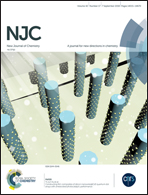A family of [Cu2], [Cu4] and [Cu5] aggregates: alteration of reaction conditions, ancillary bridges and capping anions†
Abstract
The phenoxido-bridged [Cu2] complex [Cu2(μ-H4L1)(μ-OH)(μ1,3-NO3)(NO3)(OH2)]·H2O (1) and its hierarchical [Cu4] and [Cu5] assemblies [Cu4(μ-H4L1)2(μ-OH)2(μ1,3-ClO4)(OH2)2](ClO4)3·2H2O (2) and [Cu5(μ-H4L1)2(μ3-OH)2(μ1,3-O2CCF3)2(O2CCF3)2](CF3COO)2 (3) were obtained from the reactions of H5L1 (2,6-bis-{(1,3-dihydroxy-2-methylpropan-2-ylimino)methyl}-4-methylphenol) with three copper(II) salts. The available NO3−, ClO4− and CF3COO− ions have been trapped for ‘spontaneous’ anion-directed ‘self-assembly’ reactions. All the synthesized complexes contain the [Cu2(μ-H4L1)(μ-OH)]2+ fragment, prone to assemble and crystallize [Cu4] and [Cu5] complexes under varying reaction conditions. They were characterized by UV-vis and IR spectroscopy, X-ray diffraction analysis and magnetic studies. A change from NO3− to ClO4− and CF3COO− results in different courses of reactions based on Cu2(μ-H4L1) fragments. Binding of NO3− provided 1 as an isolated [Cu2] complex by trapping the reactive fragment. In 2 a perchlorate ligand, in the μ1,3-binding mode, has been realized as a solitary support for the condensation of two Cu2(μ-H4L1) fragments. The {Cu5(μ3-OH)2(μ1,3-O2CCF3)2}6+ constellation in 3 contains five CuII centers with a unique Z-in distorted octahedral one at the central position. Binding of different anions to the copper(II) centers controls the nuclearity of the reaction products and tuning of the self-aggregation process within the same ligand environment (μ-H4L1−). The magnetic properties of the compounds have been studied both experimentally and using DFT calculations, revealing moderate to strong antiferromagnetic coupling in all aggregates.
![Graphical abstract: A family of [Cu2], [Cu4] and [Cu5] aggregates: alteration of reaction conditions, ancillary bridges and capping anions](/en/Image/Get?imageInfo.ImageType=GA&imageInfo.ImageIdentifier.ManuscriptID=C8NJ02131G&imageInfo.ImageIdentifier.Year=2018)


 Please wait while we load your content...
Please wait while we load your content...